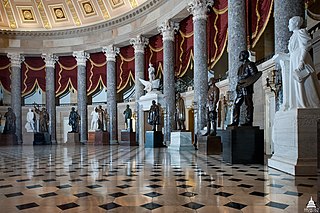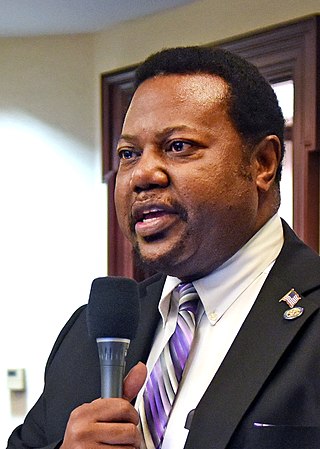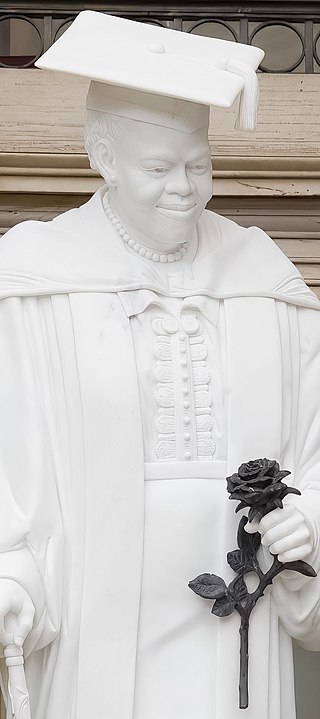
The National Statuary Hall is a chamber in the United States Capitol devoted to sculptures of prominent Americans. The hall, also known as the Old Hall of the House, is a large, two-story, semicircular room with a second story gallery along the curved perimeter. It is located immediately south of the Rotunda. The meeting place of the U.S. House of Representatives for nearly 50 years (1807–1857), after a few years of disuse it was repurposed as a statuary hall in 1864; this is when the National Statuary Hall Collection was established. By 1933, the collection had outgrown this single room, and a number of statues are placed elsewhere within the Capitol.

General Edmund Kirby Smith was a senior officer of the Confederate States Army who commanded the Trans-Mississippi Department from 1863 to 1865. Before the American Civil War, Smith served as an officer of the United States Army.

The National Statuary Hall Collection in the United States Capitol is composed of statues donated by individual states to honor persons notable in their history. Limited to two statues per state, the collection was originally set up in the old Hall of the House of Representatives, which was then renamed National Statuary Hall. The expanding collection has since been spread throughout the Capitol and its Visitor's Center.

Mary Jane McLeod Bethune was an American educator, philanthropist, humanitarian, womanist, and civil rights activist. Bethune founded the National Council of Negro Women in 1935, established the organization's flagship journal Aframerican Women's Journal, and presided as president or leader for a myriad of African American women's organizations including the National Association for Colored Women and the National Youth Administration's Negro Division.

Alachua County Public Schools is a public school district serving Alachua County in North Central Florida. It serves approximately 29,845 students in 64 schools and centers.
Confederate monuments and memorials in the United States include public displays and symbols of the Confederate States of America (CSA), Confederate leaders, or Confederate soldiers of the American Civil War. Many monuments and memorials have been or will be removed under great controversy. Part of the commemoration of the American Civil War, these symbols include monuments and statues, flags, holidays and other observances, and the names of schools, roads, parks, bridges, buildings, counties, cities, lakes, dams, military bases, and other public structures. In a December 2018 special report, Smithsonian Magazine stated, "over the past ten years, taxpayers have directed at least $40 million to Confederate monuments—statues, homes, parks, museums, libraries, and cemeteries—and to Confederate heritage organizations."

Mary McLeod Bethune Memorial is a bronze statue honoring educator and activist Mary McLeod Bethune, by Robert Berks.

More than 160 monuments and memorials to the Confederate States of America and associated figures have been removed from public spaces in the United States, all but five since 2015. Some have been removed by state and local governments; others have been torn down by protestors.
Robert E. Lee is a bronze sculpture commemorating the general of the same name by Edward Virginius Valentine, formerly installed in the crypt of the United States Capitol as part of the National Statuary Hall Collection. The statue was given by the commonwealth of Virginia in 1909. On December 21, 2020, the sculpture was removed from the grounds of the United States Capitol and relocated to the Virginia Museum of History & Culture.

Joseph Wheeler is a bronze sculpture commemorating the Confederate and American military commander and politician of the same name by Berthold Nebel, installed in the United States Capitol as part of the National Statuary Hall Collection. The statue was gifted by the state of Alabama in 1925.

Alexander H. Stephens is a marble sculpture commemorating the American politician of the same name by Gutzon Borglum, installed in the United States Capitol as part of the National Statuary Hall Collection. The statue was gifted by the state of Georgia in 1927.

Jefferson Davis, created by Henry Augustus Lukeman, is a bronze sculpture of Jefferson Davis – a U.S. Senator, U.S. Secretary of War, plantation owner and the only President of the Confederate States of America – commissioned by the U.S. State of Mississippi for inclusion in National Statuary Hall Collection at the United States Capitol's National Statuary Hall, in Washington, D.C. The statue was controversial at the time of its unveiling and there have been multiple efforts to remove it from the Capitol since 2015.

James Paul Clarke is a marble sculpture depicting the American politician of the same name by Pompeo Coppini, installed in the United States Capitol's National Statuary Hall Collection, in Washington, D.C., as one of two statues gifted by the U.S. state of Arkansas. The 6 foot 10 inch tall statue was placed in the Hall in 1921. The work cost $7,500. and was unveiled in Washington in 1921.

The National Statuary Hall Collection holds statues donated by each of the United States, portraying notable persons in the histories of the respective states. Displayed in the National Statuary Hall and other parts of the United States Capitol in Washington, D.C., the collection includes two statues from each state, except for Virginia which currently has one, making a total of 99.
The Florida Slavery Memorial is a planned site to commemorate the struggles and suffering of slaves with a memorial at the Florida Capitol in Tallahassee. Support for the planned memorial was approved by Florida's legislators and signed into law by Florida governor Rick Scott in 2018. It was sponsored by representative Kionne McGhee from Miami. Florida is also sending a statue of Mary McLeod Bethune to the U.S. Capitol. State Senator Dennis Baxley, a descendant of a Confederate soldier, had blocked a memorial bill a year earlier but supported the bill that passed in 2018. The Florida House of Representatives passed the bill unanimously. Slaves worked on Florida's 1826 territorial capitol and the 1845 capitol building, as well as many major infrastructure projects in the state. The planned monument would be the first monument at a U.S. state capitol to memorialize slavery.

Equal Visibility Everywhere, also known as EVE, is a non-profit 501(c)(3) organization based in Miami, Florida. EVE was founded in 2010 by the psychologist and former college professor Lynette Long, with the mission "to achieve gender parity in the monuments, symbols, and icons, of the United States." Its ongoing projects include adding more statues of women to the National Statuary Hall Collection, creating new historical markers honoring America's heroes, adding images of women to America's paper currency and coins, increasing the number of women honored on stamps and Google Doodles, and increasing the number of female character balloons in parades.

There are several works of art in the United States Capitol honoring former leaders of the Confederate States of America and generals in the Confederate States Army, including seven statues in the National Statuary Hall Collection, busts and portraits.

Patrick Henry is a Democratic politician who served as a member of the Florida House of Representatives, representing the 26th District, which stretches from Daytona Beach to DeLand in northern Volusia County, from 2016 to 2018.

The statue honoring civil rights and women's rights activist Mary McLeod Bethune was unveiled in the United States Capitol in Washington, D.C., representing Florida in the National Statuary Hall Collection on July 13, 2022. This makes her the first black American represented in the National Statuary Hall Collection.














